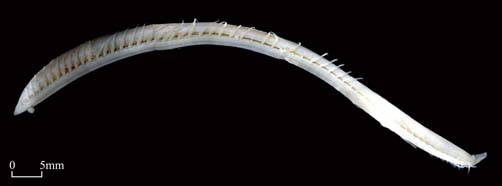Order Opheliida
Family Opheliidae
Features |
| Body: |
fusiform with a limited number of
segments; usually with a deep ventral furrow |
| Prostomium: |
conical or blunt; no appendage |
| Eye: |
2 |
| Antennae: |
absent |
| Cirri: |
absent |
| Palp: |
absent |
| Pharynx: |
eversible |
| Parapodium: |
biramous or uniramous; with small
button-shaped parapodial lobes |
| Setea: |
capillary, either smooth or marginally
dentate |
| (Fauchald 1977) |
Biological Notes
There are three distinct body
shapes: some ophellids are short, thick and grub-shaped; some are slender, nearly smooth
and torpedo-shaped; others are anteriorly inflated and posteriorly cylindrical or narrow
(Fauchald 1977).
Ophellids are fusiform
worms with a ventral groove. They burrow head downwards in sand or mud. The
respiratory current is brought down by peristalic action and escapes along the lateral
grooves which bear gills. Ophelia are common in clean sand while other
genera are found in mud (Day 1967).
Genera and Species Reported in Hong Kong
Ophelina acuminata |

